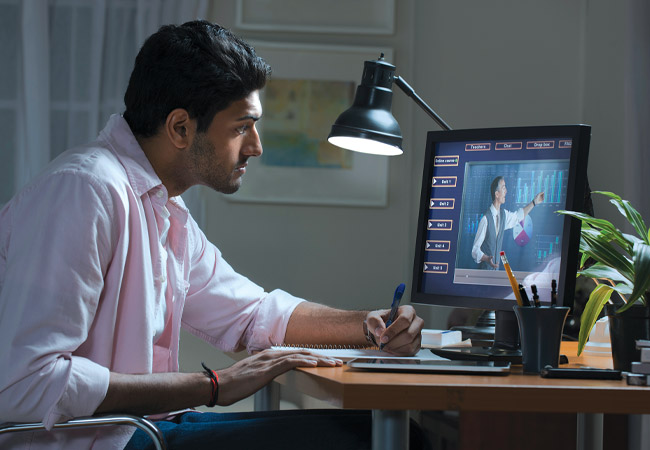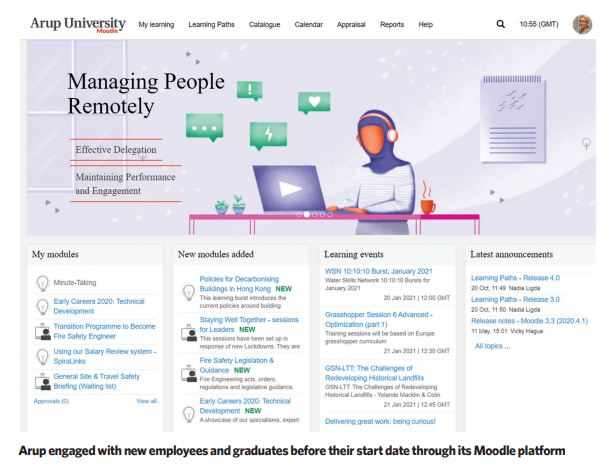
Covid-19 has forced thousands of employees in building services to swap comfortable offices for spare bedrooms and kitchen tables in their own homes. Working from home has the biggest impact on new company starters and graduate trainees, who miss out on the opportunity to meet and get to know colleagues in a physical work environment.
Over the past 10 months, companies have had to adapt existing schemes, and use technology to deliver training at home and integrate newcomers into a workplace culture. They have had to come up with new ways to welcome and train engineers who are starting out on their careers.
Graduate recruits
Building services consultant Sweco has recently integrated six new graduate trainees remotely. Peter Holmes is an associate who leads the graduate recruitment and development schemes.
‘One of the challenges has been to help them feel part of the company’s identity and community when they’re not, initially, physically in the office,’ he says. ‘When we have had it open, we’ve worked really hard to create an engaging environment – but, for a new joiner, it is a challenge, and we’ve had to work hard on integrating them.’
As well as the challenges of moving to an online learning model, the lack of informal office interaction that facilitates the exchange of ideas and knowledge – and which supports new graduates – is something that has also been difficult, says Holmes.
‘Having some of those discussions that happen when you go for a coffee – those are important, and elements that we do miss,’ he says.
Sweco has provided young mentors for graduates who have started their engineering career under lockdown, in an effort to pass on what the mentor learned during their first months at the company (see panel, ‘Online mentoring’).
Aecom also has an online mentoring scheme for its graduates and apprentices. ‘Training people virtually when they’re at the start of their career is particularly challenging,’ says Sarah Hodgens, early careers manager at Aecom. ‘We’re currently creating peer-to-peer mentoring groups and buddy systems for new starters, to help build our virtual community and mirror some of the interactions these groups would usually experience face to face.’
This, she adds, builds on an Aecom event for 400 new graduates and apprentices in January 2020, which provided the opportunity for peer-to-peer interaction before the pandemic.
Covid-19 meant Arup had to shelve its week-long residential inductions for around 300 graduates and apprentices. ‘As a result, we designed a pre-employment engagement strategy, coupled with a comprehensive onboarding plan,’ says Kamila Kaczkowska, the company’s senior learning manager (technical learning).
The content was made available to newcomers through a customised version of Arup’s Moodle learning platform (see screenshot on page 24), and connected them with their teams and buddies earlier than usual.
ONLINE MENTORING

Toby Crofts

Alex Clay
Toby Crofts joined Sweco as a graduate in 2018 and recently completed the scheme. He is a mentor to Alex Clay, a graduate who joined the company in October 2020, and his experiences have provided useful insights into what his mentee may be missing.
‘What I learned a lot from being in the office is who’s good at what – who you should talk to about certain things, who’s the resident expert on a subject; picking up things like that.
‘You overhear conversations and start to understand how the dynamics of the office work and the culture of the company. When you’re speaking to the same two or three people every day, you miss out on that.
You also don’t get as much feedback, seeing how someone’s coping with a task, dipping in to help when needed.’
Clay agrees: ‘It’s those quick type of questions that have probably suffered the most by communicating via Teams – if you’re next to someone [physically], rather than being remote, they’ll pick up if you’re unsure or need a quick clarification on something.’
Work culture
Getting new starters integrated into the culture has been an issue most organisations are keen to address. For Aecom, it meant offering them a virtual version of the firm’s cultural initiatives, such as its Freedom to Grow campaign, which encourages employees to find a working style and balance that suits them best.
Kaczkowska says Arup made sure its new intake had an extensive programme of virtual and online activities, which allowed them to meet their teams and interact with each other at office, regional and cross-discipline levels. ‘Various modules and events have been organised to help them learn about some of the key themes in our firm,’ she explains.
Consultant David Fitzpatrick developed a remote training environment for manufacturer and contractor Exyte Hargreaves, and says integrating starters into a company culture requires a more focused approach.
‘The way that we’ve found works is to block off a half-hour session with the trainees, on a one-to-one basis, to start talking about culture,’ he says. ‘People have commented that they enjoy getting time with a senior person in the business; you don’t necessarily get that one-to-one interaction under normal circumstances.’
It’s not just about putting everything online. People get bored very quickly when they are on a Teams meeting for two or three hours… We’ve broken it down into 20-minute sessions
Exyte Hargreaves’ head of HR, James Hoare, says the line manager will integrate a new team member into the business after the employee has undertaken inductions on topics such as health and safety, IT and HR.
‘Regular discussions are taking place between employee and line manager, particularly during probation, to ensure successful onboarding,’ he says.
DELIVERING CIBSE’S COURSES
In response to the first lockdown, CIBSE’s face-to-face courses were adapted for an online format, which combined text, pre-recorded videos of the trainer, and quiz questions. These courses were run on CIBSE’s pre-existing learning management system, which already had a catalogue of online courses.
‘Covid-19 has forced us to adapt our training, and make it safe and convenient for attendees. They can now save time on commuting, and money on expenses,’ says Lara Archer, CIBSE’s corporate training manager, who adds that trainers have had to ensure courses are engaging to make them effective online.
‘We keep them interactive – by adding quizzes and Q&As – and break them up, so it’s not just the trainer talking.
‘Our trainers are used to presenting face to face, so it has been an adjustment – especially because many of them work off a crowd. This is why we have tried to encourage viewers to keep their cameras on, and to put their mics on when they have a question.’
Details of CIBSE’s training events are at: www.cibse.org/trainingevents/cibse-training
Adapting technology
Kaczkowska says Arup already had a well-established portfolio of learning – including classroom, online and virtual methods – but still had to adapt.
‘We’ve rolled up our sleeves and put our efforts into converting any core, classroom-based training into online and virtual modules,’ she says. ‘Some of the previous technology used proved to be insufficient when virtual learning became the new normal. We moved quickly to invest in sourcing better systems and training internal subject experts to use them effectively.’
Shifting from largely office-based training to remote learning brings the challenge of translating an interactive physical experience into an environment that is based around video calls and webinars. For some, that has meant developing their own learning structure.
‘Through trial and error, we have developed a structured delivery model for our interactive learning modules,’ says Aecom’s Hodgens. ‘One of the best ways our graduates and apprentices respond to virtual content is through smaller, instructor-led training sessions that allow for learners to input and interact with one another,’ she says.
At the start of the first lockdown, Aecom introduced fortnightly webinars on subjects that graduates and apprentices felt were important, such as ‘developing skills in virtual working’ and ‘building resilience and adaptability’.
Fitzpatrick, meanwhile, says developing a remote graduate-training environment for Exyte Hargreaves’ intake of five graduates was about trying a very different approach from more familiar workplace-based learning.
Our trainers are used to presenting face to face, so it has been an adjustment – especially because many of them work off a crowd
‘It’s not just about putting everything online. People get bored very quickly when they are sitting on a Teams meeting for two or three hours. We’ve made it interactive, and broken it down into 20-minute sessions of teaching – but with testing at the end of each session to make sure the trainees have taken in the knowledge.’
Getting onsite experience presented another challenge, says Fitzpatrick, but technology is at least enabling people to visit project sites (though not in the flesh). ‘We have been uploading media, from people wearing cameras, for graduates to view. It’s not the same as a real site visit, but it’s better than just looking at documents; we’ll definitely take it into training post-Covid.’

New normals
For many organisations, any return to ‘normal’ working practices post-Covid is likely to bring some change, as positive lessons from remote-working experiences are adopted. Sweco’s Holmes says remote learning has accelerated the adoption of digital-collaboration practices within the wider team, and recorded CPD sessions, for ongoing internal learning, now mean employees can refer back to them later.
‘That works very well,’ says Sweco’s Crofts. ‘People are definitely asking more questions and there’s more of an open discussion. We’ve got better at sharing information, and having that information in one place for reference.’
Sweco says other initiatives borne out of necessity under lockdown will be adopted when life returns to normal. For example, graduates will be invited to attend client meetings virtually, after Sweco found that trainees gained a deeper level of experience when engaging with clients remotely in meetings (which they would not have attended pre-Covid).
‘It’s not necessarily just the way we work internally, but the way we work with clients and architects,’ says Holmes. ‘There’s been quite a recognition that the Teams meetings can be just as good as physical meetings, if not better, for some sessions. They are able to have more engagement with a project and interaction with their peers on projects, which is great.’
Exyte Hargreaves’ Hoare also wants to keep the remote-learning system in place. ‘When things return to “normal”, we will continue to look at training solutions that are digital, which can be effectively delivered remotely rather than from a classroom.’
He adds that the firm will look at having its own platform, where employees can select e-learning modules and build on their CPD.
Despite some of the unforeseen benefits remote learning has brought, getting back to a more normal training environment is, naturally, a priority for everyone.
‘Having always endeavoured to work towards a blended learning programme, there will always be a place for virtual elements,’ says Hodgens, from Aecom. ‘But we very much look forward to bringing together our graduates and apprentices in person again in the future.’



